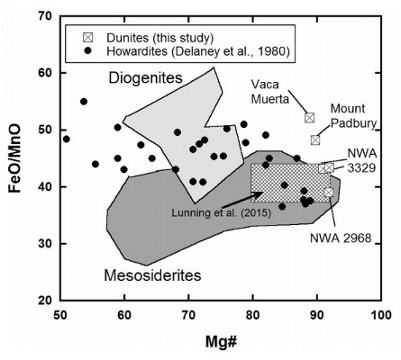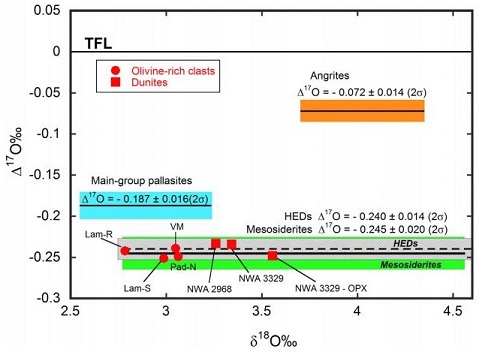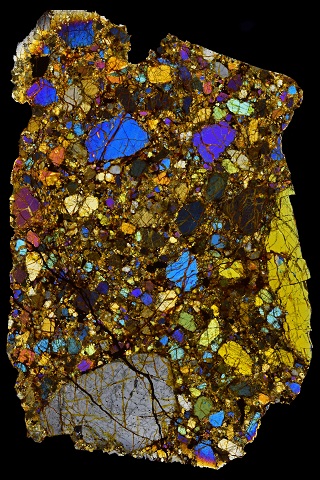NWA 3329
DiogeniteDiogenites belong to the evolved achondrite HED group that also includes howardites and eucrites. They are named after the Greek philosopher Diogenes of Apollonia, of the 5th century BCE, who was the first to suggest that meteorites come from outer space (a realization forgotten for over 2,000 years). They are Click on Term to Read More
OrthopyroxeniteA rock composed primarily of orthopyroxene. Non-terrestrial orthopyoxenites include diogenites and a single martian meteorite, ALH 84001, that was found in the Allan Hills region of Antarctica in 1984. ALH 84001 is a cumulate rock consisting of 97% coarse-grained, Mg-rich orthopyroxene, with small amounts of plagioclase, chromite, and carbonate. It Click on Term to Read More
(≥90 vol% orthopyroxeneOrthorhombic, low-Ca pyroxene common in chondrites. Its compositional range runs from all Mg-rich enstatite, MgSiO3 to Fe-rich ferrosilite, FeSiO3. These end-members form an almost complete solid solution where Mg2+ substitutes for Fe2+ up to about 90 mol. % and Ca substitutes no more than ~5 mol. % (higher Ca2+ contents occur Click on Term to Read More)
Purchased Spring 2005
no coordinates recorded A fragmented stone weighing 252 g was collected in Algeria from a similar location as NWA 2968. The fragments were subsequently purchased in Er-Rachidia, Morocco by collector F. Kuntz. A sample of these fragments was analyzed at the University of Washington at Seattle (A. Irving and S. Kuehner) and NWA 3329 was determined to be a diogeniteDiogenites belong to the evolved achondrite HED group that also includes howardites and eucrites. They are named after the Greek philosopher Diogenes of Apollonia, of the 5th century BCE, who was the first to suggest that meteorites come from outer space (a realization forgotten for over 2,000 years). They are Click on Term to Read More composed primarily of coarse-grained, dark brown orthopyroxene, together with interstitialTerm applied to ions or atoms occupying sites between lattice points. Click on Term to Read More plagioclaseAlso referred to as the plagioclase feldspar series. Plagioclase is a common rock-forming series of feldspar minerals containing a continuous solid solution of calcium and sodium: (Na1-x,Cax)(Alx+1,Si1-x)Si2O8 where x = 0 to 1. The Ca-rich end-member is called anorthite (pure anorthite has formula: CaAl2Si2O8) and the Na-rich end-member is albite Click on Term to Read More, silicaSilicon dioxide, SiO2., phosphate, FeNi-metal, and FeS.

Diagram credit: Greenwood et al., 2015
For an explanation of the diagram components see the open access article in GCA, vol. 169, p. 130 (2015)
‘GeochemistryStudy of the chemical composition of Earth and other planets, chemical processes and reactions that govern the composition of rocks and soils, and the cycles of matter and energy that transport Earth's chemical components in time and space. Click on Term to Read More and oxygenElement that makes up 20.95 vol. % of the Earth's atmosphere at ground level, 89 wt. % of seawater and 46.6 wt. % (94 vol. %) of Earth's crust. It appears to be the third most abundant element in the universe (after H and He), but has an abundance only Click on Term to Read More isotopeOne of two or more atoms with the same atomic number (Z), but different mass (A). For example, hydrogen has three isotopes: 1H, 2H (deuterium), and 3H (tritium). Different isotopes of a given element have different numbers of neutrons in the nucleus. Click on Term to Read More composition of main-group pallasites and olivine-rich clasts in mesosiderites:
Implications for the “Great Dunite Shortage ” and HED-mesosiderite connection’
(https://doi.org/10.1016/j.gca.2015.07.023)

Diagram credit: Greenwood et al., 2017
For an explanation of the diagram components see the open access article in Chemie der Erde – Geochemistry, vol. 77, p. 25 (2017)
‘Melting and differentiationA process by which a generally homogeneous chondritic body containing mostly metal, silicates and sulfides will melt and form distinct (differentiated) layers of different densities. When the melting process continues for a long enough period of time, the once chondritic body will re-partition into layers of different composition including Click on Term to Read More of early-formed asteroids: The perspective from high precision oxygen isotope studies’
(http://dx.doi.org/10.1016/j.chemer.2016.09.005) A comparison of reflectance spectra of seven near-Earth asteroids to those of HED-group meteorites revealed that all of the pyroxeneA class of silicate (SiO3) minerals that form a solid solution between iron and magnesium and can contain up to 50% calcium. Pyroxenes are important rock forming minerals and critical to understanding igneous processes. For more detailed information, please read the Pyroxene Group article found in the Meteoritics & Classification category. Click on Term to Read More mineralogies were consistent with eucritesMost common type of achondrite meteorite and a member of the HED group. Eucrites are basalts composed primarily of pigeonite and anorthite (An60-98). Eucrites have been placed into three subgroups based on mineralogical and chemical differences. • Non-cumulate eucrites represent the upper crust that solidified on a magma ocean after Click on Term to Read More and howardites, but not to diogenites. Therefore, they suggest that there are no km-sized or larger objects composed strictly of diogenite material, but instead, diogenites might exist as a single component within a mixture of lithologies on the HED asteroid. Beck et al. (2012) identified the first olivine-rich melt material present in the howardites of the PCA 02009 pairing group. This olivine-rich material was likely derived from harzburgitic and dunitic lithologies exposed on the surface of VestaThird largest and fourth brightest asteroid; it was discovered in 1807 by Heinrich Olbers and named for the ancient Roman goddess of the hearth. 4 Vesta has a basaltic surface composition and an average density not much less than that of Mars. Evidently lava once flowed here indicating that the. Further investigation employing the Antarctic DOM 10 howarditeOne type of meteorite in the HED (Howardite, Eucrite, Diogenite) achondrite group. Howardites are named after the English chemist Edward Howard (1774-1816), one of the pioneers of meteoritics. Consisting mostly of eucritic and diogenitic clasts and fragments, howardites are polymict breccias. However, they can also contain dark clasts of carbonaceous Click on Term to Read More pairing group was conducted by Hahn et al. (2018). They sought to identify Mg-rich harzburgitic (distinguished from diogenitic) silicates (Mg# >80 and >85 for olivineGroup of silicate minerals, (Mg,Fe)2SiO4, with the compositional endpoints of forsterite (Mg2SiO4) and fayalite (Fe2SiO4). Olivine is commonly found in all chondrites within both the matrix and chondrules, achondrites including most primitive achondrites and some evolved achondrites, in pallasites as large yellow-green crystals (brown when terrestrialized), in the silicate portion Click on Term to Read More and pyroxene, respectively) that represent HED mantleMain silicate-rich zone within a planet between the crust and metallic core. The mantle accounts for 82% of Earth's volume and is composed of silicate minerals rich in Mg. The temperature of the mantle can be as high as 3,700 °C. Heat generated in the core causes convection currents in Click on Term to Read More material. From results of a comprehensive geochemical analysis, they contend that these Mg-rich fragments are not related to cumulateIgneous rock composed of crystals that have grown and accumulated (often by gravitational settling) in a cooling magma chamber. Click on Term to Read More diogenites, but instead are more consistent with a mantle residue that was affected by a late infiltration of metasomatic melt. In addition, they determined that QUE 93148 also likely represents a mantle residue from the HED parent bodyThe body from which a meteorite or meteoroid was derived prior to its ejection. Some parent bodies were destroyed early in the formation of our Solar System, while others like the asteroid 4-Vesta and Mars are still observable today. Click on Term to Read More. The larger degree of partial meltingAn igneous process whereby rocks melt and the resulting magma is comprised of the remaining partially melted rock (sometimes called restite) and a liquid whose composition differs from the original rock. Partial melting occurs because nearly all rocks are made up of different minerals, each of which has a different melting Click on Term to Read More (~35–55%) required to produce the observed Mg-rich lithologies, considered to be mantle residua, is attributed by Hahn et al. (2018) to a hybrid magma oceanCompletely molten surfaces of terrestrial planets or moons that formed soon after accretion. Samples returned by the Apollo missions provide evidence of a lunar magma ocean, crystallization of which produced a stratified Moon with a low-density crust formed by accumulation of the mineral plagioclase overlying a higher density mantle of Click on Term to Read More model that combines aspects of the magmaMolten silicate (rock) beneath the surface of a planetary body or moon. When it reaches the surface, magma is called lava. Click on Term to Read More ocean model of Mandler and Elkins-Tanton (2013) and the shallow magma ocean model of Neumann et al. (2014) (see diagrams B and D below).

click on image for a magnified view Diagram credit: Hahn et al., MAPS, vol. 53, #3, p. 541 (2018)
‘Mg-rich harzburgites from Vesta: Mantle residua or cumulates from planetary differentiation?’
(http://dx.doi.org/10.1111/maps.13036) Further information regarding the origin of the dunitic clasts in our collections can be found on the Vaca Muerta page. To see an alternative classification systemDefinable part of the universe that can be open, closed, or isolated. An open system exchanges both matter and energy with its surroundings. A closed system can only exchange energy with its surroundings; it has walls through which heat can pass. An isolated system cannot exchange energy or matter with for the diogenites and dunites based on mineralogical and petrographical features, proposed by Beck and McSween (2010) and modified by Wittke et al. (2011), click here. The photo shown above is a 0.52g fragment of NWA 3329. The photo below is an excellent petrographic thin sectionThin slice or rock, usually 30 µm thick. Thin sections are used to study rocks with a petrographic microscope. micrograph of NWA 3329, shown courtesy of Peter Marmet.

click on image for a magnified view
Photo courtesy of Peter Marmet







